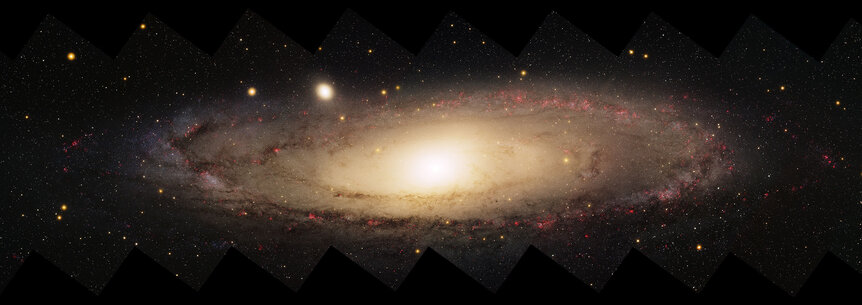Two billion years ago, Andromeda ate the Milky Way’s sibling

Our Milky Way galaxy is a huge, sprawling disk of gas, dust, and stars — a few hundred billion stars. It’s part of a small clutch of galaxies called the Local Group, and is the second largest member. The largest is the Andromeda Galaxy, with very roughly twice as many stars as we have.
The third largest is the Triangulum Galaxy, which is only one-tenth the mass of the Milky Way.
But Triangulum wasn’t always in third place. It may have once been fourth. New research indicates that, a couple of billion years ago, there was a galaxy with well over twice as many stars as Triangulum. It’s not around anymore, though.
Andromeda ate it.
We know that galaxies grow by eating other galaxies; there are lots of interacting and colliding galaxies out there in space. The details of what happens in such a collision depend on lots of things like the speeds and the masses of the two galaxies involved. If both are around the same size they both suffer greatly in the event, getting torn apart by each others’ gravity, flinging stars out in huge, sweeping arcs called “tidal tails,” and eventually settling down into one larger but seriously disturbed galaxy.
If one is much smaller than the other, it can get its outer parts stripped away, leaving the denser core behind to fall toward the bigger galaxy’s core. In both cases, stars ripped away can form looping elliptical streams that can travel around the remaining galaxy for hundreds of millions of years.
This has likely happened dozens if not hundreds of times for both the Milky Way and Andromeda since they both initially formed. There’s actually more than one such stellar stream identifiable in our galaxy right now, the half-digested bits of previous galactic meals.
There have been hints that Andromeda ate something decently large a couple of billion years ago. There’s a giant stream of stars circling it, for example. Older stars appear to be agitated in their motion in the galaxy’s disk, as if some big event stirred them up roughly two billion years ago. There’s an uptick of stars that formed around that time, too, which is consistent with it eating a galaxy rich in gas (which is where stars come from).
The new research adds to that: The astronomers posit that the galaxy Andromeda consumed was in fact pretty big — the third-largest galaxy in the Local Group at the time — and that the nucleus of that galaxy is still around… and is in fact M32, a dwarf elliptical companion to the big spiral!
That part gave me a shock. M32 is obvious in pretty much every picture ever taken of Andromeda, and in fact is really easy to spot by eye in small telescopes. Its origin has always been a mystery; it’s very compact and dense with stars, more so than you’d expect for a dwarf elliptical companion. The stars in it have a high abundance of heavy elements (heavier than hydrogen and helium, the simplest elements), which is weird for an elliptical, and it has a lot of intermediate-age stars, when you’d expect them all to be very old.
This new idea would explain all that! What we now see as M32 is actually the core of the bigger galaxy that got et — in fact, the astronomers dubbed it M32p, for “M32 Progenitor.” It turns out the motion of M32 around Andromeda is consistent with the giant stream of stars too, which supports this idea. If this collision did in fact occur, then that stream is debris from M32p getting ripped apart by Andromeda, and it dominates the material orbiting Andromeda from about 25,000 – 80,000 light years out from its core.
Collisions like this take a couple of hundred million years. According to the research, the galaxies approached one another, and the gravity of Andromeda started to pull stars and gas from M32p, distorting its shape. It plowed through the disk of Andromeda, getting pulled into a long stream like taffy. Many of the stars are still in Andromeda’s halo, the large, very roughly spherical distribution of stars surrounding the galaxy, while the core of M32p kept on keeping on, its gravity and relatively compact size saving it from being torn apart as well.
A very interesting aspect of this is that it’s thought that collisions between two big galaxies will result in an elliptical galaxy. However, while thicker than average, Andromeda’s disk clearly survived, even though M32p had between 10 – 30% of the mass as Andromeda’s disk. If this new work turns out to be correct, it’ll mean rethinking disk collisions.
So how firm are these results? I’d say better than 50/50, at a guess. It’s hard to find a smoking gun here; instead what we have is a lot of circumstantial evidence. But it is a lot, enough that I’m all for following up and seeing what else can be dug up to support it.
And I must admit, I’m biased. I’ve seen M32 a zillion times; once I get Andromeda in my low power eyepiece, the first thing I usually do is readjust the pointing to put M32 in there as well. I love seeing two galaxies at once, knowing that the smaller compact cotton ball off to the side is a companion satellite to the far larger Andromeda (which itself is easily visible to the naked eye from a northern hemisphere dark spot in the late summer/early fall).
But now, knowing that M32 might actually be the indigestible core of a much more massive galaxy, one that used to be one of the dominant triumvirate of galaxies in the local universe?
That would make it even cooler. I hope that turns out to be the case.
































